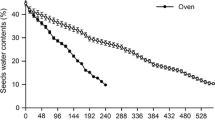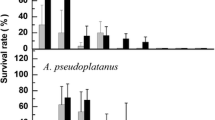Abstract
The desiccation sensitivity in relation to the stage of development was investigated in embryonic axes from the homoiohydrous (recalcitrant) seeds of Landolphia kirkii. Electrolyte leakage, used to assess membrane damage after flash (very rapid) drying, indicated that axes from immature (non-germinable) seeds were the most desiccation-tolerant, followed by those from mature seeds, while axes from seeds germinated for increasing times were progressively more desiccation-sensitive. Differential scanning calorimetry was used to study the relationship between desiccation sensitivity and the properties of water in the tissues. Axes from immature seeds had a lower content of non-freezable water than that of any other developmental stage and a higher enthalpy of melting of freezable water. For mature and immature axes electrolyte leakage increased at the point of loss of freezable water. At other developmental stages the water content at which electrolyte leakage increased markedly correlated with the other properties of the water, such as the change in the shape of the melting endotherm and the onset temperature. Ultrastructural studies of axes at the various developmental stages showed changes in the degree and pattern of vacuolation, the presence and quantities of lipid and starch, and the degree of endomembrane development. The results are discussed in relation to current hypotheses on the basis of desiccation tolerance.
Similar content being viewed by others
Abbreviations
- DSC:
-
differential scanning calorimetry
References
Berjak, P., Farrant, J.M., Pammenter, N.W. (1990a) The basis of recalcitrant seed behaviour. Cell biology of the homoiohydrous seed condition. In: Recent advances in development and germination of seeds, pp. 89–108, Taylorson, R.B., ed. Plenum, New York
Berjak, P., Farrant, J.M., Mycock, D.J., Pammenter, N.W. (1990b) Recalcitrant (homoiohydrous) seeds: the enigma of their desiccation-sensitivity. Seed Sci. Technol. 18, 297–310
Chin, H.F., Roberts, E.H., eds (1980) Recalcitrant crop seeds. Tropical Fress, SDN.BHD. Kuala Lumpur, Malaysia
Clegg, J. S. (1986) The physical properties and metabolic status of Anemia cysts at low water contents: The “Water Replacement Hypothesis”. In: Membranes, metabolism and dry organisms, pp. 169–187, Leopold, A.C. ed., Comstock Publishing Associates, Ithaca, London
Crowe, J.H., Crowe, L.M. (1986) Stabilization of membranes in anhydrobiotic organisms. In: Membranes, metabolism and dry organisms, pp. 188–209, Leopold, E.C. ed., Comstock Publishing Associates, Ithaca, London
Farrant, J.M., Pammenter, N.W., Berjak, P. (1985) The effect of drying rate on viability retention of recalcitrant propagules of Avicennia marina. S. Afr. J. Bot. 51, 432–438
Farrant, J.M., Pammenter, N.W., Berjak, P. (1988) Recalcitrance -a current assessment. Seed Sci. Technol. 16, 155–156
Farrant, J.M., Pammenter, N.W., Berjak, P. (1989) Germination-associated events and the desiccation sensitivity of recalcitrant seeds — a study on three unrelated species. Planta 178, 189–198
Hong, T.D., Ellis, R.H. (1990) A comparison of maturation drying, germination, and desiccation tolerance between developing seeds of Acer pseudoplatanus L. and Acer platanoides L. New Phytol. 116, 589–596
Leopold, A.C., Vertucci, C.W. (1986) Physical attributes of desiccated seeds. In: Membranes, metabolism and dry organisms, pp. 22–34, Leopold, A.C. ed., Comstock Publishing Associates, Ithaca, London
Normah, M.N., Chin, H.F., Hor, Y.L. (1986) Desiccation and cryopreservation of embryonic axes of Hevea brasiliensis Muell. Arg. Pertanika 9, 299–303
Pammenter, N.W., Vertucci, C.W., Berjak, P. (1991) Homeohydrous (recalcitrant) seeds: Dehydration, the state of water and viability characteristics in Landolphia kirkii. Plant Physiol. 96, 1093–1098
Pritchard, H.W., Prendergast, F.G. (1986) Effects of desiccation and cryopreservation on the in vitro viability of the recalcitrant seed species Araucaria hunsteinii K. Shum. J. Exp. Bot. 37, 1388–1397
Probert, R.J., Brierley, E.R. (1989) Desiccation intolerance in seeds of Zizania palustris is not related to developmental age or the duration of post-harvest storage. Ann. Bot. 64, 669–674
Probert, R.J., Longley, P.L. (1989) Recalcitrant seed storage physiology in three aquatic grasses. Ann. Bot. 63, 53–63
Roberts, E.H. (1973) Predicting the storage life of seeds. Seed Sci. Technol. 1, 499–514
Vertucci, C.W. (1989) Relationship between thermal transitions and freezing injury in pea and soybean seeds. Plant Physiol. 90, 1121–1128
Vertucci, C.W. (1990) Calorimetric studies of the state of water in seed tissues. Biophys. J. 58, 1463–1471
Vertucci, C.W., Leopold, A.C. (1987) The relationship between water binding and desiccation tolerance. Plant Physiol. 85, 232–238
Author information
Authors and Affiliations
Rights and permissions
About this article
Cite this article
Berjak, P., Pammenter, N.W. & Vertucci, C. Homoiohydrous (recalcitrant) seeds: Developmental status, desiccation sensitivity and the state of water in axes of Landolphia kirkii Dyer. Planta 186, 249–261 (1992). https://doi.org/10.1007/BF00196255
Accepted:
Issue Date:
DOI: https://doi.org/10.1007/BF00196255




